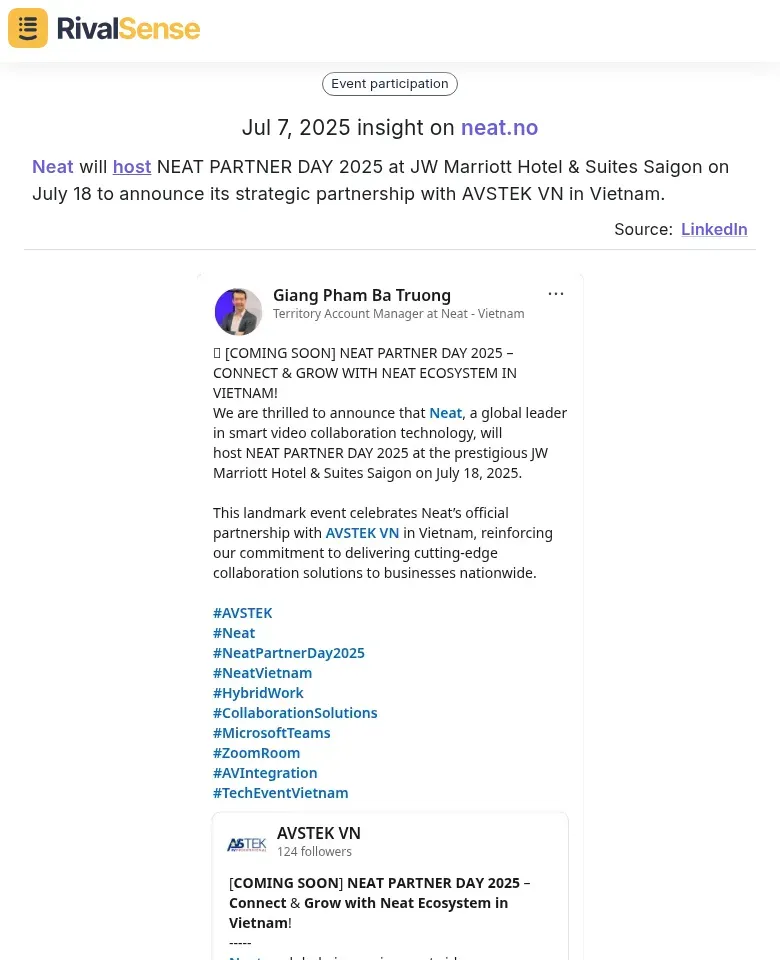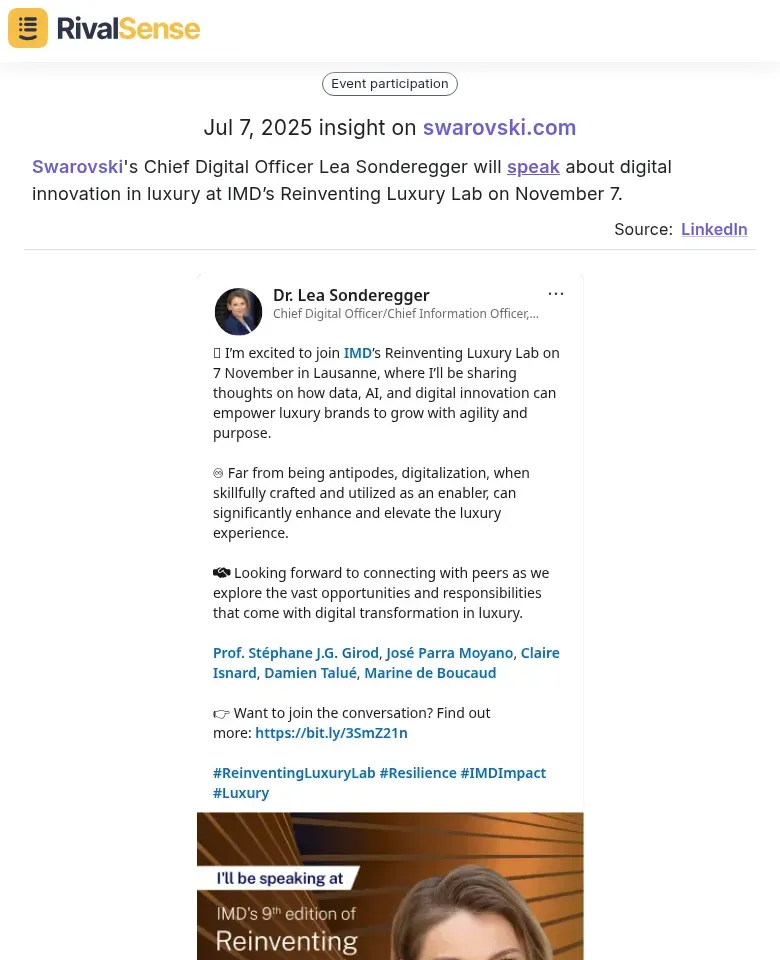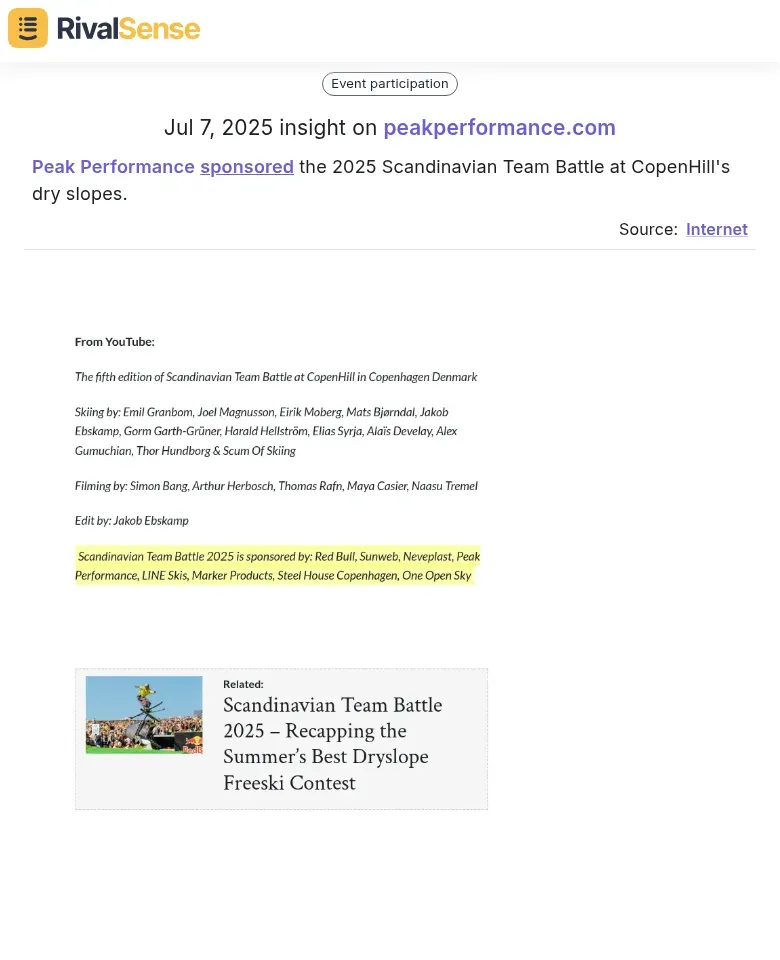Unlock Strategic Wins: How to Gain Competitor Insights from Event Participation
Understanding competitors' event participation unlocks invaluable strategic intelligence. Industry events serve as transparent stages where companies reveal priorities, innovations, and future directions through their involvement. By systematically tracking which conferences, trade shows, or webinars competitors attend or sponsor, you gain direct visibility into their market focus and strategic maneuvers.
For example, a competitor consistently appearing at AI conferences signals a pivot toward AI-driven solutions. Sponsorship of niche events often indicates targeted customer segment focus. To capitalize on this intelligence:
- Identify Key Events - Use tools like RivalSense to monitor industry calendars
- Track Participation Levels - Note speaker/sponsor/attendee roles
- Analyze Content Themes - Extract strategic clues from presentations
- Spot Patterns - Identify recurring event types or geographic focuses
📊 Sample Competitor Event Tracker:
| Event Name | Date | Competitor | Role | Key Themes |
|---|---|---|---|---|
| Tech Summit | Aug 15 | Competitor A | Speaker | AI Integration |
| Global Expo | Sep 3 | Competitor B | Sponsor | Sustainability |
Analyzing Strategic Partnerships Announcements
Partnership announcements at events provide windows into expansion strategies and capability gaps. These collaborations often reveal technology sharing, market entry plans, or product enhancement initiatives before formal launches. By decoding partnership implications, you can anticipate competitive shifts and identify white space opportunities.
Consider this real-world insight:
Neat hosted 'NEAT PARTNER DAY 2025' in Saigon to announce their strategic partnership with AVSTEK VN
Tracking such announcements helps you:
- Predict market expansion timelines
- Identify potential competitive threats
- Uncover partnership opportunities
Action Framework:
- ✅ Create a partnership impact matrix (tech vs. market access vs. capabilities)
- ✅ Monitor event hashtags for real-time announcements
- ✅ Analyze partner profiles for strategic alignment clues
Learning from Competitor Speaking Engagements
Speaking slots reveal what competitors deem strategically important enough to share publicly. Presentation topics expose innovation priorities, while audience engagement levels indicate market resonance. Thought leadership positioning often precedes product launches or market repositioning.
Notice how speaking topics telegraph strategy:
Swarovski's CDO spoke about digital innovation in luxury at IMD’s Reinventing Luxury Lab
This insight provides three strategic advantages:
- Identifies emerging focus areas
- Reveals expertise gaps competitors are addressing
- Signals upcoming market trends
Decoding Checklist:
- 🔍 Note topic consistency across events
- 🔍 Record Q&A session revelations
- 🔍 Compare presentation depth year-over-year
Evaluating Sponsorship and Branding Opportunities
Sponsorship choices reveal budget allocation priorities and audience targeting strategies. The scale and type of sponsored events indicate whether competitors are pursuing broad awareness or niche penetration. Consistent sponsorships in specific regions or verticals highlight growth priorities.
Observe this real sponsorship insight:
Peak Performance sponsored the 2025 Scandinavian Team Battle at CopenHill's dry slopes
Such intelligence helps you:
- Benchmark competitor marketing investments
- Identify underserved audiences
- Predict geographic expansion patterns
ROI Assessment Metrics:
- 📈 Social media mentions during event
- 📈 Share of voice vs. investment
- 📈 Lead generation correlation
Actionable Strategies for Leveraging Insights
Transform raw event data into competitive advantage through systematic analysis. Begin by cataloging insights in a centralized tracker, then identify patterns indicating strategic shifts. Align your event participation to counter competitors' moves while highlighting your unique differentiators.
Implementation Blueprint:
1. Collect → Use automated tools to track events
2. Categorize → Tag by type (conference, trade show, webinar)
3. Analyze → Identify frequency, themes, partnerships
4. Act → Adjust your event strategy based on gaps
SWOT Application:
| Strengths | Weaknesses | |
|---|---|---|
| Opportunities | Host events in competitors' underserved regions | Counter-sponsor key industry gatherings |
| Threats | Develop content addressing their presentation topics | Form partnerships with their target sponsors |
Conclusion and Key Takeaways
Event participation intelligence delivers unparalleled visibility into competitors' strategic priorities. By systematically tracking partnerships, speaking engagements, and sponsorships, you gain advance warning of market shifts and new competitive threats. The most successful businesses transform these insights into proactive counter-strategies.
Key implementation steps:
- Establish continuous monitoring of competitor event activities
- Analyze patterns across event types and geographies
- Align your event strategy to exploit identified gaps
🚀 Ready to decode competitors' event strategies?
Get automated tracking of product launches, partnerships, and speaking engagements with RivalSense's free trial. Receive your first competitor intelligence report today!
📚 Read more
👉 Why Vincent Olmo's Swarovski Appointment Demands Your Attention
👉 Market Intelligence for Threats: Turning Data into Strategic Advantage
👉 Unlocking Remote Hiring Success: The Power of Trial Experiences
👉 How IT.integro's Strategic Shift Ignited ERP Innovation: Lessons for Business Leaders
👉 Unlock Competitor Secrets: How Twitter Intelligence Drives B2B Strategy



